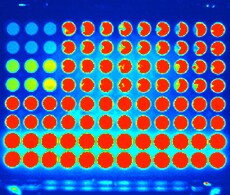Search Thermo Fisher Scientific
Microplate Assays for Enzyme Activity

EnzCheck Assays provide a rapid and convenient way to measure a range of enzyme activities using fluorescent reporters in a robust assay format. Each assay kit provides the necessary assay buffers, uses a simple protocol and defines the optimum wavelength for sensitive detection. The microplate format is convenient for high throughput analysis using a 200 µL assay volume. We offer assays for proteases, collagenases, elastases, lysozyme, reverse transcriptase, and RNA-dependent RNA polymerase.
Explore our portfolio of easy-to-learn, easy-to-use plate readers
Protease assays
The EnzChek Protease Assay Kits contain a casein derivative that is heavily labeled with either the green-fluorescent BODIPY FL or red-fluorescent BODIPY TR-X dye. The conjugates typically exhibit <3% of the fluorescence of the corresponding free dyes. Following the assay, the observed increase in fluorescence is directly proportional to protease activity. Because EnzChek assays do not involve any separation steps, they can be used for continuous measurement.
Other enzyme assays
We've also developed EnzChek Assay Kits for gelatinase/collagenase, elastase, lysozyme, and reverse transcriptase that are reported by intramolecular self-quenched substrates, allowing continuous, sensitive monitoring of enzyme kinetics.
| EnzChek Protease Assay Kit, Green Fluorescence | EnzChek Protease Assay Kit, Red Fluorescence | |
|---|---|---|
| Target | Protease | Protease |
| Reporter | BODIPY FL conjugate | BODIPY TR-X conjugate |
| Ex/Em (nm) | 505/513 | 589/617 |
| Live cell | No | No |
| Lysate | Yes | Yes |
| Purified enzyme | Yes | Yes |
| Usage | Detection limit varies by protease | Detection limit varies by protease |
| Components | Includes assay buffers | Includes assay buffers |
| Format | 1,000 assays using 200 µL reaction volume | 1,000 assays using 200 µL reaction volume |
| Protocol outline |
|
|
| Cat. No. | E6638 | E6639 |
| EnzChek Gelatinase/Collagenase Assay Kit | EnzChek Elastase Assay Kit | EnzChek Lysozyme Assay Kit | EnzChek Reverse Transcriptase Assay Kit | |
|---|---|---|---|---|
| Target | Collagenase/Gelatinase | Elastase | Lysozyme | Reverse transcriptase |
| Reporter | Fluorescein conjugate | BODIPY FL Conjugate | Fluorescein conjugate | PicoGreen reagent |
| Ex/Em (nm) | 495/515 | 505/515 | 495/515 | 480/520 |
| Live cell | No | No | No | No |
| Lysate | Yes | Yes | Yes | Yes |
| Purified enzyme | Yes | Yes | Yes | Yes |
| Usage | Lower detection limit 2 x 10–4 U/mL | Lower detection limit 5 x 10–3 U/mL | Lower detection limit 20 U/mL | Lower detection limit 2 x 10–3 U/mL |
| Components | Includes assay buffers and controls | Includes assay buffers, inhibitor, and controls | Includes assay buffers and controls | Includes assay buffers |
| Format | 250–1,000 assays depending on substrate concentration | 600 assays using 200 µL reaction volume | 400 assays using 100 µL reaction volume | 1,000 assays using 200 µL reaction volume |
| Protocol outline |
|
|
|
|
| Cat. No. | E12055 | E12056 | E22013 | E22064 |
| EnzChek Protease Assay Kit, Green Fluorescence | EnzChek Protease Assay Kit, Red Fluorescence | |
|---|---|---|
| Target | Protease | Protease |
| Reporter | BODIPY FL conjugate | BODIPY TR-X conjugate |
| Ex/Em (nm) | 505/513 | 589/617 |
| Live cell | No | No |
| Lysate | Yes | Yes |
| Purified enzyme | Yes | Yes |
| Usage | Detection limit varies by protease | Detection limit varies by protease |
| Components | Includes assay buffers | Includes assay buffers |
| Format | 1,000 assays using 200 µL reaction volume | 1,000 assays using 200 µL reaction volume |
| Protocol outline |
|
|
| Cat. No. | E6638 | E6639 |
| EnzChek Gelatinase/Collagenase Assay Kit | EnzChek Elastase Assay Kit | EnzChek Lysozyme Assay Kit | EnzChek Reverse Transcriptase Assay Kit | |
|---|---|---|---|---|
| Target | Collagenase/Gelatinase | Elastase | Lysozyme | Reverse transcriptase |
| Reporter | Fluorescein conjugate | BODIPY FL Conjugate | Fluorescein conjugate | PicoGreen reagent |
| Ex/Em (nm) | 495/515 | 505/515 | 495/515 | 480/520 |
| Live cell | No | No | No | No |
| Lysate | Yes | Yes | Yes | Yes |
| Purified enzyme | Yes | Yes | Yes | Yes |
| Usage | Lower detection limit 2 x 10–4 U/mL | Lower detection limit 5 x 10–3 U/mL | Lower detection limit 20 U/mL | Lower detection limit 2 x 10–3 U/mL |
| Components | Includes assay buffers and controls | Includes assay buffers, inhibitor, and controls | Includes assay buffers and controls | Includes assay buffers |
| Format | 250–1,000 assays depending on substrate concentration | 600 assays using 200 µL reaction volume | 400 assays using 100 µL reaction volume | 1,000 assays using 200 µL reaction volume |
| Protocol outline |
|
|
|
|
| Cat. No. | E12055 | E12056 | E22013 | E22064 |
Expertly detect fluorescence with Thermo Scientific plate readers

High-sensitivity fluorescence detection for 6-1,536 samples can be quickly performed on the Varioskan ALF or Varioskan LUX Multimode Microplate Reader using Invitrogen reagents to enable optimal detection. Take advantage of automatic dynamic range selection to get optimal gain settings for each individual well and automation capabilities for even higher throughput.
Resources
For Research Use Only. Not for use in diagnostic procedures.